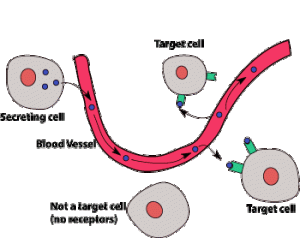Tagged: hormone
Comparing Nervous and Hormonal Coordination: Grade 9 Understanding for IGCSE Biology 2.86
This topic requires you to understand how nervous and hormonal coordination compare and to understand the differences between the two systems.
Coordination is the life process by which organisms can detect and respond to a change in the environment. These changes in the environment that can be detected are called stimuli. A stimulus can be outside the body (e.g. the air temperature dropping) or internal (e.g. an increase in the concentration of glucose in the blood after a meal).
How do organisms detect and respond to stimuli?
There are two systems that can bring about coordination:
- Nervous System
- Hormonal System (also known as the Endocrine system)
The nervous system is made up of around 100 billion specialised cells called neurones. Neurones (nerve cells) are adapted in that they can transmit an electrical event called nerve impulse (or sometimes an action potential) rapidly from one end of the cell to the other. You should understand the simplest pattern of nervous coordination which is called a reflex arc.

The hormonal system works in a completely different way. There are no electrical impulses in the hormonal system. A hormone is a chemical that is released into the blood stream and exerts an effect at a target tissue elsewhere in the body.
Have a read of my blog post on hormones to find out more…..

If you understand how these two systems are able to link one part of the body to another, then you can see how these two compare.

The first rows in the table have already been discussed.
Because the nerve impulse travels along a neurone at up to 100 m/s you can see that the nervous response will be much faster than a hormone that is secreted into the blood. It can take up to a minute or two for a hormone to travel from the secreting cell to the target cell. So nervous coordination is fast, hormonal is slow.
The response to a nervous signal often only lasts for a short time. Nervous responses tend to be muscle contractions and these are temporary of course. Hormones on the other hand often are involved in longer term processes like growth and development. As an example, think of the changes brought about at puberty by the hormones testosterone (in men) and oestrogen (in women).
Finally you can compare where the response occurs. Nerve cells can only cause a response at the exact point where they end. They release neurotransmitters into a synapse and this exerts an effect on the next neurone or muscle cell. Because hormones are released into the blood plasma, and blood is carried everywhere in the body, a single hormone can effect many targets in the body. For example, adrenalin (epinephrine for our American cousins) is a hormone released by the adrenal gland above the kidneys. But the target tissues for adrenalin are found all over the body – e.g. the heart, the skeletal muscles, the iris in the eye, the hairs in the skin, the lungs, the liver etc. Read more about adrenalin in my blog post here.
I hope this helps….. Please leave a comment in the box below to either give me some feedback, give me some suggestions for future posts or to ask a question.
Adrenaline: Grade 9 Understanding for IGCSE Biology 2.94
Adrenaline is a hormone produced in the adrenal glands which are found on top of the kidneys in the abdomen.
A hormone is “a chemical released by a specialised gland called an endocrine gland into the bloodstream. The hormone travels around the body in the blood plasma and then causes an effect elsewhere in the body by binding to receptors found on certain target cells”.
You should know some other examples of hormones – testosterone, oestrogen, progesterone, ADH – to name a few. Please learn this definition too: it would be wonderful if you got a 3 mark question asking you to define a hormone….
There are many cells in the body that contain receptors for adrenaline. This allows the hormone to exert an effect on a wide variety of tissues. For example there are adrenaline receptors in the pacemaker of the heart and adrenaline will cause the heart to beat faster (more beats per minute) and also with more force.
When is adrenaline released by the adrenal glands into the blood?
Adrenaline is secreted into the blood in times of danger or stress. It prepares the body to either run away from the danger or indeed to battle against it. For this reason, adrenaline is often described as a “fight or flight” hormone.
What are some of the effects of adrenaline?
Target Tissue Effect
Heart Increase in heart rate, increase in cardiac output
Lungs Bronchioles dilate (widen)
Muscles Arteries in muscle dilate to allow more blood to flow to muscles
Skin/Digestive system Arteries in skin/digestive system constrict so less blood flows
Liver Liver breaks down glycogen into glucose to raise blood glucose conc.
Iris Radial muscles in iris contract causing pupil dilation
The overall effect is that the skeletal muscles are supplied with more oxygen and more glucose so they can respire aerobically. This allows the muscle to contract more efficiently.


